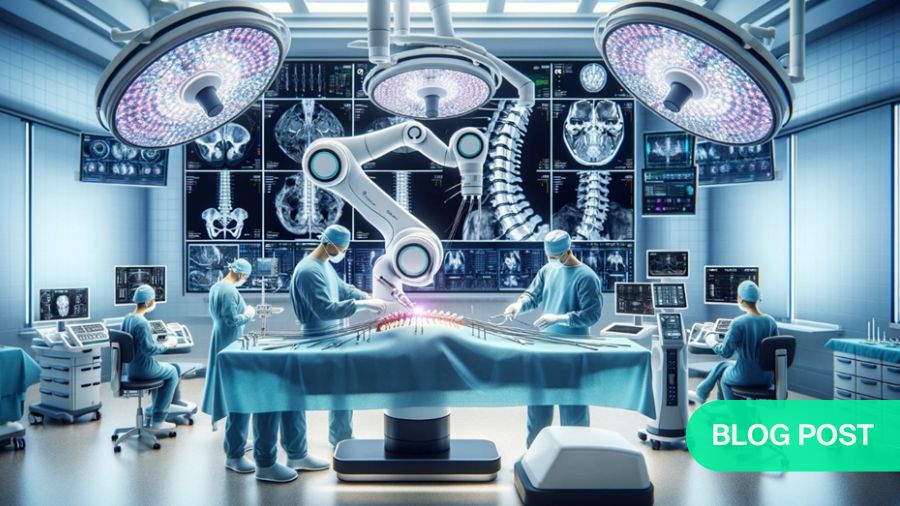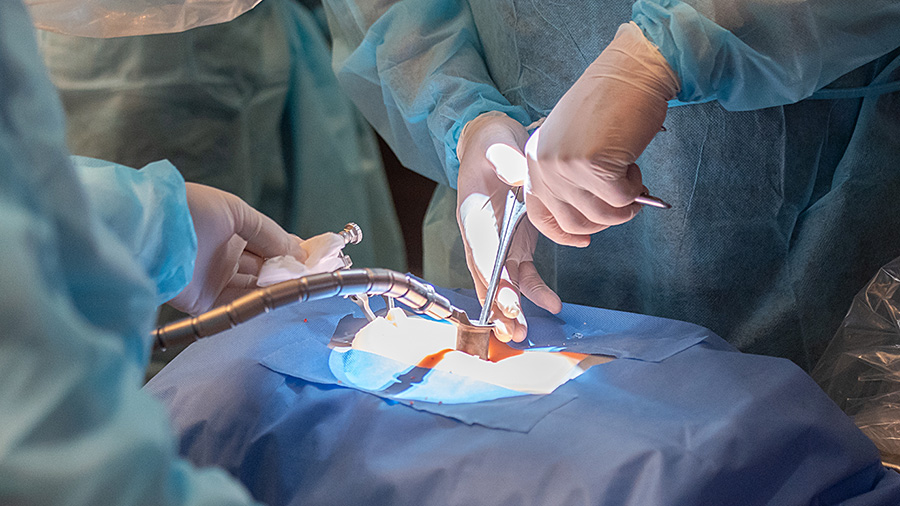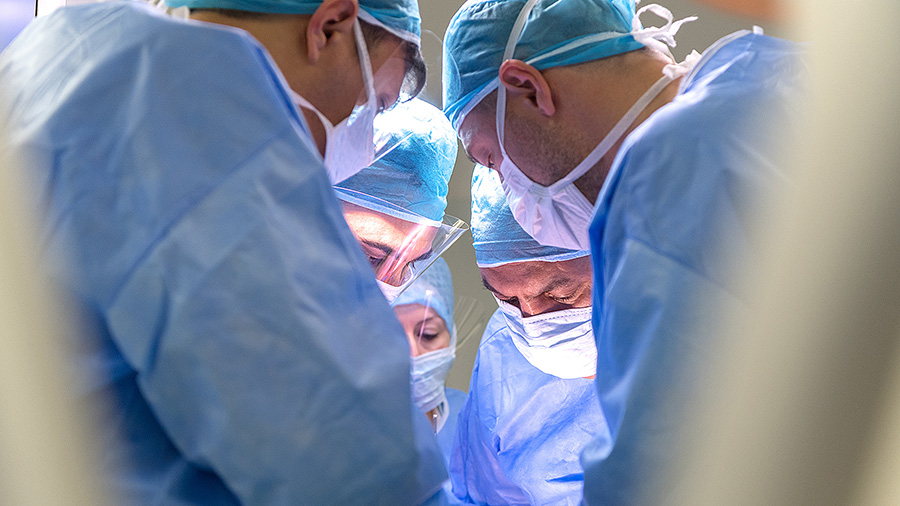AI and machine learning in spine surgery—a potential game changer
BY DR SAMEH ABOLFOTOUH

No matter where you look these days, Artificial Intelligence is without doubt the topic of the moment. The technology is increasingly being integrated into most aspects of our daily lives, and many believe that it will revolutionize countless industries. It stands to reason that one of them may well be spine surgery. In recent years, technological solutions based on Artificial Intelligence (AI) and machine learning have attracted considerable funding and investment, including in the medical sector. It is expected that by 2032, investment in healthcare-related AI technology will reach 21 billion dollars globally.
Disclaimer: The article represents the opinion of individual authors exclusively and not necessarily the opinion of AO or its clinical specialties.
One of the trailblazers in this regard has been the AI-powered screening of chest X-ray images for over a dozen pathologies. The procedure was approved by the United States Food and Drugs Administration (FDA) in 2019 and is now routinely being used in hospitals across the US.
AI has also successfully been used in the diagnosis and treatment of neurodegenerative diseases, in hematological testing, as well as in the diagnosis and management of arrhythmias. In 2020, a study showed that AI was able to outperform primary healthcare physicians in the majority of the cases in terms of correctly diagnosing general health problems such as diabetes and hypertension.
AI is a hot topic also at the Global Spine Congress
Judging from the programs of our specialty's major academic events of the past year, it becomes clear that spine care is about to experience significant transformations due to the advent of AI. While in previous years, most conferences would have featured one or maybe two lectures on the topic, we now have dedicated sessions at every single major event, including the Global Spine Congress. In the past, we would often talk about the advantages of certain screws over others. Now we are looking at groundbreaking advances as the realization takes hold that AI will be nothing less than a major paradigm shift.
To me, this is a major step forward, and, significantly, it comes at the right time. Demographic change and the rapidly growing proportion of ageing people globally mean that medical professionals will increasingly be treating older patients.
The problem with those patient populations is that there is a very high risk of complications—when we operate on patients in this age bracket, the complication rate stands at between 55 and 70 percent in adult spine deformity surgeries. The numbers differ somewhat depending on which study you look at, but even at the lower extreme, they are very high.
Of course, one way of mitigating these risks could be to cease operating within this patient population altogether. However, we know from the literature that patients over the age of 65 with frailty benefit a lot from successful surgery. That is why it is important to figure out a perfect balance between decreasing the risk of complication as much as we can while at the same time actively increasing quality of life for as many patients as possible.
This is where AI potentially has a major role to play: the technology may offer us a way of optimizing those surgeries and of decreasing the complication risk. On the one hand, AI-supported predictive analysis could help us better determine whom we should—and whom we should not—operate on in the first place. On the other hand, AI systems could provide valuable assistance in terms of surgical planning and intraoperative optimization.
Driving up prediction accuracy in spine surgery
As soon as a patient walks into their clinic, surgeons begin to collate a wide variety of parameters: we look at their BMI, ASA, ODI and BMD, as well as at comorbidities. We also factor in their sagittal parameters, and we check whether they smoke or use narcotics. All of this is an attempt to gauge the potential risk of surgery, and ultimately to decide whether it may be worth operating on a patient and potentially going through the hassle of complications, or whether surgery should be ruled out altogether.
The problem with this approach is that even for the most excellent and experienced surgeons, it remains exceedingly difficult to keep abreast of all those parameters—the human brain simply is not equipped to deal with so many different variables. However, machines can. They can incorporate hundreds and hundreds of variables at the same time as a basis for a risk analysis.
The concept has already been proven by the International Spine Study Group (ISSG). Back in 2019, they developed an algorithm to predict the risk for just over 1600 patients who had already been operated on in the past. The machine was accurate an astonishing 89 percent of the time.
Contrast that with a separate ISSG study from 2016, for which 39 of the busiest deformity surgeons in the world were asked to assess, in nine different real-world cases of operated-on adjacent segment disease, the likelihood of major complications and reintervention after certain times had elapsed since the operation. The results were all over the place. For instance, some surgeons predicted that no patient would experience major complications, while other surgeons figured the rate at 100 percent. So, we have to face up to the fact that even the best among us may not be as good as they think in terms of predicting patient outcomes.
Factoring out human emotion improves accuracy
Luckily, a remedy is at hand. While the predictions of different surgeons may be totally discordant and heterogenous, the machine shows no statistical difference between predicted and observed outcomes. To say it bluntly: the machine is much better. Part of the reason is that, unlike us humans, the algorithm has no feelings. Physicians take a lot of decisions every single day in their ORs that are based on, and feed back into, their emotions. For example, we might see a patient in our clinic who developed a post-operative complication. If we then operate on a similar patient later that same day, we are much likelier to predict that they will end up with the same complication.
As humans, our emotions will always be a part of the equation whenever we deal with patients. The machine does not have that problem. It plots the patient on a map, and it compares them to thousands of past surgery patients with comparable risk parameters. It then calculates a risk or an expected outcome for the patient that is based exclusively on hard empirical data.
Last year, I and several colleagues published a paper about the predictors of postoperative spinal wound infection in the Middle East and North Africa (MENA) region. At the time, I was very excited about the research, because it was the first time that we were able to inform patients in this specific group about their particular risks based on data from the MENA region rather than from North America or Europe.
But as I grow as a spine surgeon, I realize that this is not enough. It simply is not fair to tell a surgeon or a patient that the complication risk for an adult spine deformity surgery is 'up to 55 percent'. Because what that means is that the risk might be two per cent, or it might be 50 percent. We need to be able to plot those patients on an exact curve and know exactly what we are dealing with and what we can anticipate. And that, in my view, is where AI has a major role to play.
AI-powered tools for planning and optimization of surgery
AI-powered support tools for surgical planning and intraoperative optimization represent another area in which we have seen investment volumes increase significantly in recent months. For instance, some of these solutions allow surgeons to simply upload X-ray images on their mobile phones. The algorithms then automatically perform all necessary measurements, take into consideration all the relevant risk variables, and deliver a ready-to-use surgical plan.
In this way, the machine can provide instructions on how and where to perform osteotomies, where to place screws and rods, and much more. The aim is to minimize post-operative complications such as rod breakage, or screw pullout, and to achieve the best possible alignment tailored to individual patients.
According to the literature, the most common reasons for having to perform additional surgery on patients are things like implant failure or rod breakage. In fact, when an osteotomy is performed, these complications historically occur in up to 22 percent of cases. AI-supported surgery planning tools are able to reduce that risk to 4.7 percent.
This is very significant because it affects the whole healthcare industry. After all, if fewer patients have to return to the operating table, it will have a direct effect on expenses. Moreover, we can also reduce the number of cases in which patients have to contend with negative outcomes from those surgeries as well, with direct benefits for their quality of life.
More accurate hospital processes save dollars
AI also has the potential to revolutionize many other aspects of healthcare. One example is billing codes, which are a very important component of every hospital's financial processes. Every single procedure that physicians perform on patients has a billing code. These codes translate the work that doctors and nurses do into standardized treatment definitions that can be reimbursed by the insurance companies. A coder who is not good at what they do can quickly end up costing their hospital millions and millions of dollars simply by entering incorrect codes.
However, that too may soon be a thing of the past. Researchers from Columbia University in New York have developed an algorithm that can automatically extract the correct billing codes from patient operative notes and send them directly to the billing department—with almost 90 percent accuracy.
Why spine surgeons should welcome AI
As is the case with any new technology I expect that AI-powered applications for spine surgery will initially face something of an uphill struggle in terms of acceptance. Spine surgeons do not like change too much. In fact, compared to other specialties, we are very late adopters, especially when it comes to new technology.
Take for example navigation in spine surgery. In 2013, a study was conducted to find out why spine surgeons were so slow on the uptake of this tool. And the number one reason given by surgeons was that they felt it delayed them in the OR, that it somehow made their workflows less smooth.
Fast forward to the present day, and the technology is well on its way to becoming the standard of care and being adopted by lots of spine surgery centers around the world.
I would urge everyone in the spine community to welcome with open arms the opportunities provided by AI in areas such as patient selection, outcome prediction, surgical planning, and education. I am not saying that we should give up our clinical sense and delegate 100 percent of our responsibilities to the machine—it is us humans who ultimately have to make all the crucial decisions. But we should make it a habit to at least consider including AI applications in our routines.
In my opinion, the spine community has a responsibility to actively contribute to the body of knowledge surrounding AI technologies and their application within the field. After all, an AI can only ever be as good as the quality of the data used to train it. One way of ensuring this—and, in the long run, to improve patient care—could be a centralized and well-curated database. One thing is certain: AI technology is here to stay. It will get better in vast increments in the near future, and we should begin to implement it into spine practice immediately.
About the author:
Dr. Sameh Abolfotouh is an orthopaedic surgeon and specialist in spine surgery at the Medcare Orthopaedic & Spine Hospital, Dubai. He is a board-certified orthopaedics and spine surgeon with orthopaedics residency from the HMC/Weill Cornell Medical College in Qatar. Abolfotouh’s interests range from minimally invasive spine surgeries to artificial disc replacement, major deformity surgery, as well as robotic spine surgery. He is current education officer of the AO Spine Middle East and Northern Africa Board.
You might also be interested in:
Minimally Invasive Spine Surgery (MISS)
MISS is a suite of technology-dependent techniques and procedures that reduces operative tissue damage. Explore the AO Spine MISS resources and courses.
AO Spine surveys
We regularly conduct regional and international research surveys with the AO Spine community, from the community, for the community.
Work-related neck pain among spine surgeons
Whether chronic or temporary, work-related neck pain among spine surgeons and has become an everyday topic of conversation. Sameh Abolfotouh dives into results from an AO Spine survey.





